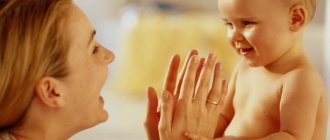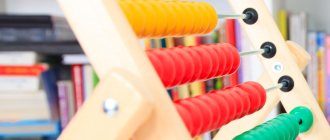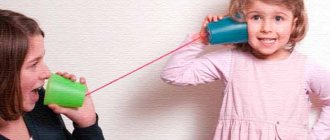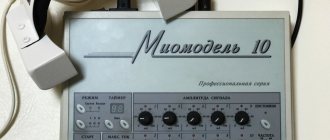Stages of development of a child’s own (expressive) speech:
Screams
- arise from birth.
Booming
– prolonged pronunciation of vowels and syllables with throat consonants (gu, agu, gee) from 2 to 5-7 months.
Against the background of a melodious hum, syllables with labial and anterior lingual sounds appear
, which then transform into babble.
Babbling
– repeated repetition of syllables, with labial and frontal consonants (ma-ma-ma, boo-boo-boo) began from 4-7.5 months.
Words
- the transition is carried out against the background of ongoing babbling: babbling words (mom, dad, bobo, bang, am, give) from 11-12 months.
The appearance of words in the adult lexicon (milk - moko, mami - take, maka - small, titiki - watch) began at 1 year 7/9 months. The coexistence of words, correctly and incorrectly pronounced, is the main pattern of the initial stages of speech development in children.
The role of parents in the treatment of mental retardation at 4 years of age
Eliminating speech development delays in 4-year-old children is a matter for specialists with the appropriate education and skills. But parents also play a big role. First of all, the situation in the family has an impact on the child’s condition, including the development of speech. Conflicts and quarrels, even if the baby is not involved in them, affect the child’s psyche. This is fraught with a slowdown in the pace of development.
In addition, in some families no one takes care of the children. They are left to their own devices. If there are prerequisites, for example, close relatives have a speech pathology, then we can talk about a hereditary factor. Such a child will have speech delays.
The next point is the presence of a person with incorrect speech in your environment. The baby will imitate him and speak incorrectly. Experts recommend protecting your child as much as possible from people with pathological speech. That is why parents should always speak correctly, pronouncing all sounds clearly and slowly. You cannot lisp the baby or distort words - this rule must be followed by all family members.
Overprotection also contributes to delayed speech development in children 4 years old. Don't demand anything supernatural from your child. Each person develops at his own pace. By overloading your son or daughter with activities, without leaving a minute of free time, you only make things worse: this is constant stress for children. This can cause other defects to appear: stuttering, enuresis, sleep disturbances.
Growth of a child’s vocabulary from one year and older
- 1 year - 5-9 words
- 1.5 years from 20 to 40 (from different authors)
- 2 years from 50 to 200 words
- 3 years from 800 to 1000 words
- 3.5 years - 1100
- 4 years 1600 - 1900
- 5 years 1900 – 2200
Development of phrasal speech
The appearance of phrases from two lexical units (Lala bah, papa am) begins from 1 year 9 months to two years.
The emergence and development of proposals - from two years.
By the age of 3, he begins to use complex subordinate clauses, questions “why?” appear. “when?”, uses almost all parts of speech, prepositions and conjunctions.
Uses singular and plural.
By the age of four, speech is grammatically correct, suffixes and more complex phrases are used.
Further development of speech is assessed mainly not by the number of words, but by the ability to answer questions, the presence of initiative in a conversation, the construction of logical chains, the ability to compose a story from a picture, talk about an event, retell a fairy tale.
At the same time, understanding of complex grammatical structures is assessed.
Corrective work for sensory alalia
Speech therapy work with non-speaking children 3-4 years old suffering from alalia is structured depending on the type of this disorder. If a diagnosis of sensory alalia has been established, then the speech understanding disorder will be corrected by working with intact analyzers, that is, through tactile, olfactory, gustatory and visual perception. The auditory system is not ignored, but is included in the work partially and only at later stages.
There are several stages of work to correct and eliminate speech disorders in the sensory type. Conventionally, they can be divided into:
- Stage I – preparatory.
- Stage II – formation of communication skills (from non-speech to speech).
- Stage III – development of interest in surrounding non-speech and speech sounds.
First stage
Before starting correctional work to eliminate speech disorders, it should be understood that, although it is customary to take methodological developments adapted for hard of hearing and deaf children as a basis, nevertheless, lack of hearing and misunderstanding of speech are two completely different concepts and require radically opposite in some cases approach. This must be taken into account when choosing techniques and methods for teaching children with sensory alalia.
These children hear, but the process of analyzing the information received is disrupted: the auditory analyzer can perceive the signal at the moment, but after some time under the same conditions it cannot. In the familiar environment of their home, they can remember individual speech structures used by adults. At the same time, when they find themselves in an unfamiliar environment, or when they come into contact with a new person, they do not understand the same statement. The auditory system of alaliks is extremely unstable; children with this perception disorder have a hard time tolerating sharp sounds (creaks, rustling), high-frequency noises, screaming or loud expressive speech. All this can lead to blocking the acoustic-gnostic process, which will only complicate the correction work. Therefore, during classes with such children it is necessary to use calm, quiet speech so as not to reduce their perception of speech sounds.
Often concomitant disorders in children with sensory or sensorimotor alalia are disturbances in the emotional-volitional sphere and behavior, so at first, classes with the child will most likely be chaotic, spontaneous. Under no circumstances should you try to force an alalik to “sit” in one place for a certain number of minutes. One of the main initial tasks is to establish contact with the child at the level of tactile and visual perception. Only after contact has been established can work begin, otherwise all efforts will go down the drain.
Second phase
Children, through joint play activities with a teacher, learn to use non-verbal communication skills - gestures, facial expressions. Later, semantic intonation is added. This happens when playing partner games with a child, for example:
"Feed the doll." The speech therapist speaks and shows what needs to be done: sits the doll on a chair (at the table), holds a spoon to the toy’s mouth, imitating “feeding,” etc. The child, in turn, performs the same actions, duplicating gestures and facial expressions. Here, motor and visual analyzers are actively involved in the work, the “eye to eye” technique is used, which allows the baby to better understand what the adult wants from him. However, this method is not suitable for children with autism, as they often tend to avoid eye contact with other people.
Games with construction sets or cubes will also be useful. This version of “parallel play” is also suitable for autistic people. Tactile and visual perception and sensation are involved. The teacher builds a tower or other structure together (if this does not cause negative emotions) or next to the child, using facial expressions and gestures. Speech is minimal, simple, monosyllabic, there should not be too many words in use, it is better to rely on those that the child perceives or can often hear.
You can also work with various aids for the development of sensory skills (color, taste, tactile features of objects) and fine motor skills: musical toys, soft and wooden cubes. The goal of the second stage is to directly formulate the need for verbal communication. It can be developed with the help of an artificially created “information hunger.”
Third stage
At this stage, the gradual development of phonemic hearing and perception begins. First with the help of non-speech sounds, then with the inclusion of adult speech. In this case, it is necessary to avoid sharp knocks, clapping of hands, and stomping. The sound is compared to the displayed image. For example, a speech therapist offers a pupil a number of illustrations for the development of subject vocabulary. Next, he parses each picture with one or more sounds corresponding to it (uu - paravoz, yy - bear, mu - cow, etc.). The same thing happens when the symbols of actions are activated: a selection of plot pictures allows you to expand the verbal dictionary (aa - cries, ay - hurts, etc.).
You can use ready-made material “My First Words” by N. A. Shishkina, developed in accordance with the modern psycholinguistic approach, and systematized into blocks for more convenient study of information. This manual is suitable for working with both sensory and motor skills.
Before starting work, it is recommended to establish a routine, clearly define the time for classes and rest. You need to try once again not to overload auditory attention and perception with speech tasks.
This stage will be fundamental in the development of speech understanding, as it will allow:
- intensify the use of words according to their purpose;
- develop the ability to analyze one’s own speech;
- replenish passive vocabulary, which, subject to the effective work of the speech therapist, will eventually turn into active;
- develop phonetic-phonemic perception: distinguish words that sound similar.
Method of starting speech.
This method of starting speech is suitable for a normotypical child (no diagnosis, understands spoken speech; hearing, vision, intellectual abilities are normal).
Why should you give up gadgets?
The technique of starting a speech starts with the simplest, and for some, “difficult”. We remove gadgets and musical toys as much as possible. Why?
- Firstly, the child does not see the correct articulation of the speech apparatus. Cartoon characters open their mouths automatically.
- Secondly, constantly changing the picture reduces the child’s concentration. It will be difficult for him to study. TV becomes dopamine for a child.
- Thirdly, the skill of listening is lost. We may not notice this (but this especially affects children) speech broadcast from TV and live speech is very different in perception. Speech from gadgets has a truncated sound. We ourselves cannot grasp it. As a result, the brain receives distorted, truncated information.
Wait. Let the child speak, and then there will be cartoons.
What to pay attention to when starting a speech?
- Development of gross motor skills. It is gross motor skills that give impetus and launch speech. The brain stem is responsible for gross motor skills and it is much more difficult to work on. “Developers” won’t help here. Important: routine, proper sleep, nutrition, movement, walks. As your child develops gross motor skills, study a body map. The child must know where his hands, feet, knees, and so on are. Offer to raise your arms and legs to the side, jump, buy a balance bike, scooter, bicycle, play with a ball, swim.
- Development of fine motor skills - works on understanding speech, syllable structure, diction. There are many options for developing fine motor skills. Playing with sand, modeling with dough or plasticine, stringing beads, playing with stones, su-jok, massages, finger games, sensory boxes, drawing on semolina.
- Articulation and breathing exercises. Choose a task based on your child’s capabilities and interests. An excellent training for the articulation of the speech apparatus would be chewing solid food (apple, carrot). Since a person pronounces all sounds and words while exhaling, the development of speech breathing is also of enormous importance.
- Speech exercises. For example: visual-rhythmic series. The child is asked to continue the given sequence, voicing it.
- Intellectual exercises. Without new knowledge, it is impossible to activate the left hemisphere, which is necessary for coherent speech.
Watch. Which of these five directions have a drawdown. Pay special attention to the lagging direction.
Do not start a conversation with your child with the words “say” or “repeat.” This can cause speech negativism and a complete refusal to communicate.
Your task, as an adult, is to build a dialogue with the child. How do we do this? Let's start asking questions.
- Do you want to go outside? (not - we’re going outside)
- Will you eat soup?
- Will you eat soup or porridge? (they put what they want first).
Let the child think, be silent, suggest, give a reaction. Don't rush him, don't answer for him. repeatedly. He must feel that he is a participant in the conversation.
Method of starting speech - calling out the first words.
- Speech automatisms: yes - no. Find something to which the child responds emotionally. Let this thing, the toy, be the basis of the “dialogue”.
- Onomatopoeia (up to 2.5 years) and sound gesture (after 2.5 years). With a sound gesture, we verbalize the action. For example: the ball fell bang. We take the ball and at every contact with the floor or table we say “bang.” Thus speech is subordinated to action.
- Verb components. (Give it, na).
- Nouns. (Who is this? What is this?)
- Adjectives (description). The simplest ones are big and small.
Starting these few words will provide the basis for further work, expanding your vocabulary.
Don't force things. There is no need to evoke both speech automatisms and verbs with a noun in 5 minutes of class. One direction of work is selected. The child must live through this speech moment and become aware of it. Only then will there be a result. The words “yes - no” can be practiced over the course of several days, or over the course of a month. Everything is individual.








